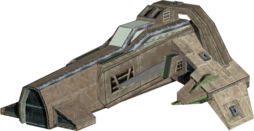IMGXF-XBF2c "Helios"
| IMGXF-XBF2c "Helios" | |
| Ship Class | Very Heavy Fighter |
| Built by | Independent Miners Guild |
| Technical information | |
| Guns/Turrets | 6 / 0 |
| Class 10 Guns | |
| Class 9 Guns | |
| Cruise Disruptor | |
| Countermeasures | |
| Mines | |
| Hull strength | 11,900 (x2.5) |
| Shield strength | 24,350 - SM e2 "Advanced Barrier" Heavy Fighter Molecular Shield |
| Cargo space | 65 units |
| Nanobots/Batteries | 64/64 |
| Max. impulse speed | 80 m/s |
| Max. thrust speed | 199 m/s |
| Power output | 5,000 u |
| Power recharge | 1000 |
- This is a player owned ship.
Designation
IMGXF-XBP2c "Helios"
Independent Miner's Guild eXperimental Fighter eXperimental Balistics Prototype Test Type 2c "High ExpLosIve Ordiance Strikecraft"
Overview
The IMGXF-XBP2c "Helios" was developed to test the effectiveness of advanced ballistics compared to the more ammo efficient, reliable and less volatile energy equivalents of energy based weapons.
The Helios may resemble a regular Lhotse, but has a completely reworked and redesigned interior. Due to the lack of need for a powercore capable of sustaining energy weapons, the Helios' power core was reduced in size and capacity, ostensibly cut in half. The extra space freed up by the smaller powercore was taken up by specialized equipment optimized for the usage of ballistic weaponry.
The only known Helios in operation is the IMG|Kamikaze, piloted by IMG Paramilitary pilot Akemi Nakamura.
Special Equipment
DLS-X1 Missile loading banks
"Disc Loading System eXperimental prototype 1", the first ever internal missile loading system dedicated to a full missile loadout. Unlike the usual method of having each missile system load individual missiles via a push mechanism, the DLS-X1 utilizes a rotating disc to load missiles into their launchers. This allows for less maintenance, lower electronics load and faster rate of fire. The only drawback is the sheer size of the system, thus not allowing it to be fitted on regular fighters. The Helios has extended space due to the usage of a smaller powercore, most of the extra space freed up is dedicated to the DLS-X1
HIM-4a Missile guidance system
Specially designed targeting systems meant specifically for missile guidance replaced traditional targeting systems meant for direct damage weaponry. Unlike traditional guidance systems that utilize the age old method of heat-seeking, the HIM-4a "Heat - Image Matching Production model 4a" "Shadow" missile guidance systems work via a combination of image and heat signature matching. By keying in both image data and specific heat data, the HIM-4a allows for better tracking and less susceptibility to heat and image based countermeasure flares.
LDVS-X2
"Low Density Viewing System eXperimental prototype 2", a specially designed view filter that utilizes a combination of radar scanning systems and guncam feedback. The LDVS-X2 was designed to reduce the amount of distractions that occur during dogfighting, limiting the viewer's sensory information down to the bare minimum. All structures are reduced to basic 2 dimensional shapes and objects too small to be cause any trouble are removed completely. Background information is removed completely and appears completely black to the pilot. Light and glares are reduced significantly so as to not distract the pilot. Enemy ships are highlighted to keep focus on the enemy. Results show that by the LDVS-X2 improves pilot efficiency by 10% by reducing the distractions around him.
Lightweight Titanium Alloy and Iridium internal skeletal system
Due to the dangers of ballistics exploding in the vicinity of the ship, a very common problem with the advent of cruise disruptors, the Helios is fitted with a specially designed shock-resistant Titanium shell, capable of withstanding shockwaves from nearby explosions. The internal Iridium skeletal system also helps maintain the integrity of internal structure and systems, so vibrations and shockwaves coursing through the ship does not cause it to collapse inwards.
M3 Skyseat
As an added precaution, a specially designed ejection system, dubbed the "M3 Skyseat" replaced the usual ejection mechanism. The M3, powered by a controlled deuterium explosions, allows for greater escape velocity, allowing the pilot to be thrown out of the explosion radius. The only drawback is the sheer force of the ejection, which would render the pilot unconscious 99% of the time. IMG scientists have devised a workaround via a special suit.
External equipment
SMSF-TT1
"Statistic Monitoring Survival Flightsuit Test Type 1" is the most recent development for the Helios. Only one of its kind was developed to this date. The SMSF-TT1 was designed specifically for one pilot, following her body measurements and vital statistics to the 10th decimal, Akemi Nakamura. This allows almost perfect synchronization with the suits' systems and features and almost zero hindrance in movement. The only drawback is that this suit, being calibrated to one person, is only able to be used by one person.
The SMSF-TT1 was specifically designed with the Helios in mind. Built in defibrillators and vital system monitors were specially added due to the high stress levels required for flying the Helios. Sudden explosions and shockwaves that rock your hull down to the last nail can be very stressful for the pilot, even to the point where cardiac arrest might occur. Defibrillators and heart rate monitors are there to ensure the absolute safety of the pilot. The additional feature of suit is the ability to jolt the pilot back into consciousness following a violent ejection and subsequent blackout.
